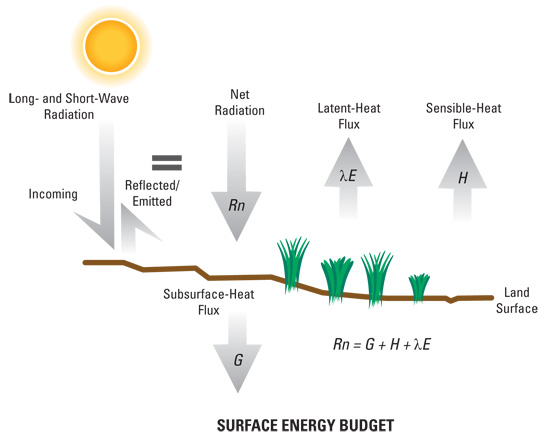How is ET measured?
The rate at which water evaporates from the earth’s surface and is transpired by plants is referred to as the ET rate. The ET rate is driven by the available solar energy. Available solar energy is the difference between incoming and outgoing long and shortwave radiation. This energy difference is defined as net radiation. Net radiation (Rn) is absorbed at the Earth’s surface, and then is partitioned into energy that is transferred by heat conduction downward into the subsurface, by heat conduction or convection upward into the atmosphere, or is used to convert water from the solid or liquid to vapor phase. The partitioning process is and described by the surface energy budget.

The latent-heat flux component (λE) of the energy budget is the energy flux used for ET. Accordingly, ET can be calculated by subtracting the sensible heat (H) and soil heat (G) flux components of the energy budget from the net radiation. However, because this approach has been hampered historically by difficulties in measuring sensible-heat flux, a common solution to calculating ET has been the use of the Bowen ratio. In simple terms, the Bowen ratio assumes that the proportionality between sensible and latent heat can be defined by the ratio between the temperature and vapor-pressure gradient. Because temperature and vapor pressure can be measured directly, the Bowen ratio can be substituted into the energy budget to solve for latent heat by directly using measurable parameters.
Another technique used to estimate ET is the eddy-covariance method. Eddy covariance measures sensible- and latent-heat fluxes directly. Eddies are turbulent airflow caused by wind, the roughness of the Earth’s surface, and convective heat flow at the boundary between the Earth’s surface and the atmosphere. ET occurs when water vapor in upward moving eddies is greater than in downward moving eddies. Likewise, sensible heat is positive when upward moving eddies are warmer than downward moving eddies. Water vapor, heat, and other scalars like carbon dioxide transferred by eddies can be measured directly using the eddy-covariance method. Over the last 25 years, many of the estimates of ET made in Nevada and the surrounding area have been based on one of these two methods. More details about these methods can be found in the publications section, and within these publications in the reference section.
